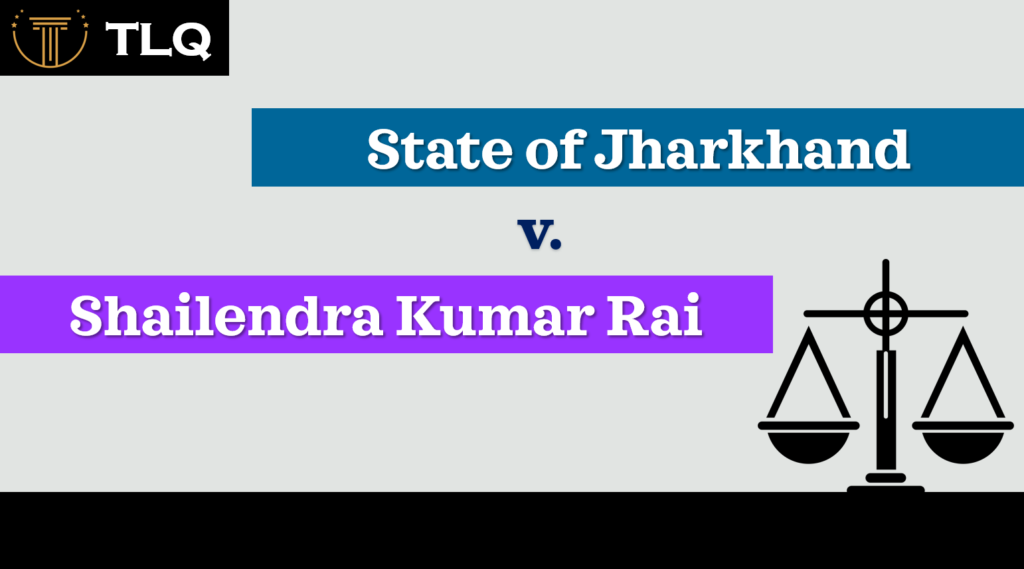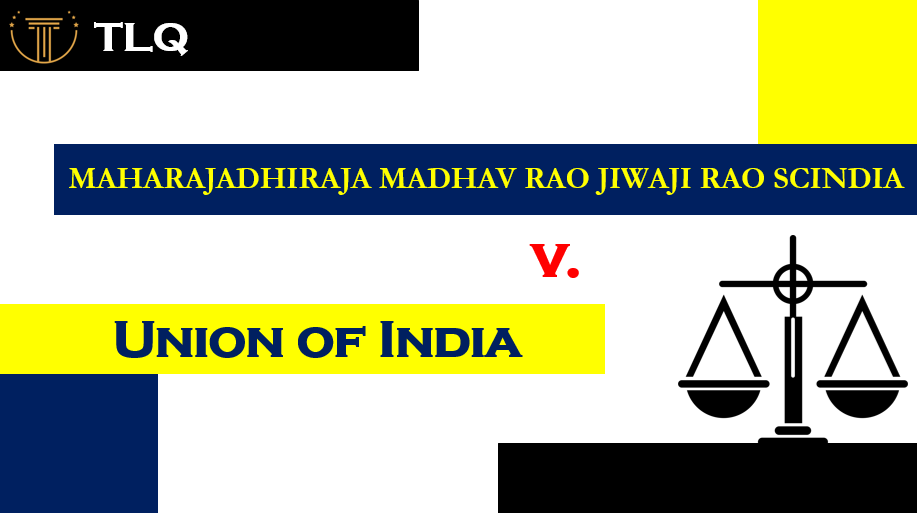Published On: 20th June, 2024
Authored By: Anish Kumar
Presidency University, Bangalore
State of Jharkhand vs. Shailendra Kumar Rai[1]
Introduction
The Supreme Court of India heard the criminal appeal State of Jharkhand vs. Shailendra Kumar Rai in 2022. The case featured an appeal filed by the State of Jharkhand against Shailendra Kumar Rai’s acquittal in a murder case by the Jharkhand High Court. On the basis that it erred in acquitting the accused, the appeal contested the High Court’s ruling.
Facts of the Case
The respondent entered the victim’s and deceased’s home in Narangi village on November 7, 2004, in the afternoon, and it was alleged that he raped her while pushing her to the ground and threatening to kill her if she raised an alarm. The case’s facts were admitted to the court as the victim’s dying declaration. She allegedly shouted out for aid, and the respondent doused her in kerosene and set her ablaze. As soon as the victim’s relatives heard her cries, they responded to put out the fire and rushed her to Sadar Hospital in Deoghar, where she was admitted and received medical attention for her wounds.
After learning about the incident, the PS Sarwna police officer-in-charge left for Deoghar to record the victim’s statement in which she described what happened. Based on the victim’s statement, a formal complaint was filed at PS Sarwna, and an investigation was launched. Following the investigation’s conclusion, the IO filed a charge sheet for offenses against Sections 307, 341, 376, and 448 of the IPC in accordance with Section 173 of the Code of Criminal Procedure 1973. Following the victim’s death on December 14, 2004, a supplemental charge sheet was filed against the respondent, citing Section 302 of the IPC.
Due to the respondent’s denial of guilt, the case proceeded to trial. According to the Sessions Court’s October 10, 2006 ruling, the respondent was found guilty of violating Sections 302, 341, 376, and 448 of the Indian Penal Code. The respondent was also sentenced to life in rigorous prison for the offense punishable under Section 302 of the IPC and ten years of rigorous imprisonment for the offense punishable under Section 376 of the IPC, both of which were ordered to run concurrently. Following that, the respondent filed an appeal with the Jharkhand High Court. On January 27, 2018, the High Court declared the Sessions Court’s ruling to be invalid and cleared the respondent.
Issues
The Supreme Court’s main concern was whether the Jharkhand High Court made a mistake by clearing the suspects. The Court had to decide whether the circumstantial evidence was properly considered by the High Court and if the evidence showed the accused’s guilt beyond a reasonable doubt.
ARGUMENTS FROM THE APPELLANT SIDE
The appellants contended that the Jharkhand High Court had misconstrued the evidence when it was stated that Dr. RK Pandey was tending to a patient on the table next to the deceased, rather than a patient in a room next to the deceased’s, which the High Court had misinterpreted. The post-mortem examination of the deceased was carried out within 12 hours of her passing away, and the report concluded that septicaemia was the cause of death because of her burn injuries.
ARGUMENTS FROM THE RESPONDENT SIDE
The respondent’s counsel opposed the submissions made on behalf of the appellant, arguing that while the dying declaration suggested that the respondent had raped the deceased, the Medical Board’s report said that no firm opinion could be formed in this regard and that there was no other evidence to support the claim that the victim was raped by the respondent and that the victim passed away approximately one month after the incident that was reported. As a result, the deceased’s statement to the IO was not a final testament.
JUDGEMENT
The High Court of Jharkhand relied on the ruling in Moti Singh v. State of Uttar Pradesh [2]to conclude that the victim’s statement was inadmissible as a dying declaration in the current case, but the Supreme Court said that this was an incorrect conclusion given the differences in the facts and circumstances of the two cases. The victim in this case died of septicaemia brought on by her burn injuries, according to the post-mortem report, which was confirmed by the Supreme Court. Consequently, the victim’s statement in this case was pertinent to both the circumstances leading up to her death and the cause of her death.
The statement therefore clearly stated that the respondent poured kerosene on her and set her on fire, and the post-mortem report also concluded that the cause of death was septicaemia caused by the burn injuries sustained by the deceased. As a result, the Supreme Court held that the statement satisfied the conditions laid down in sub-clause (1) of Section 32 as it related to both the cause of death and the circumstances of the transaction which resulted in death. Furthermore, the decedent’s evidence revealed that the respondent had sexually assaulted her prior to setting her ablaze. This account of the events leading up to her demise fulfilled the requirements outlined in Section 32(1) and was in and of itself a relevant fact.
The Supreme Court ruled that there was no rule stating that a dying declaration recorded by a police officer rather than a magistrate was inadmissible, with regard to both the declaration’s admissibility and probative value. Here, the Supreme Court also relied on its judgment given in Khushal Rao v. State of Bombay[3], where it had formulated the yardstick against which dying declarations may be evaluated which included that a dying declaration has to be on the same footing as another piece of evidence and has to be judged on the basis of facts and circumstances of each case and to test the reliability of such declaration, focus has to be given on the capacity of the person to remember the facts stated and whether he had been impaired or not, at the time of making the statement, by circumstances beyond his control. The Court had also stated the importance of the statement being consistent throughout and of making the statement at the earliest opportunity to eliminate the chance of tutoring by interested parties.
The Supreme Court cited the ruling in Ram Bihari Yadav v. State of Bihar[4], which found that the absence of questions and answers did not affect the admissibility or probative value of a deathbed declaration.
The High Court had mistakenly noted, according to the Supreme Court, that during Dr. RK Pandey’s cross-examination, he had been seeing a different patient in the adjoining room when the victim’s deathbed declaration was recorded. The cross-examination record revealed that contrary to what the High Court had falsely claimed, Dr. RK Pandey was evaluating a patient on the adjacent table rather than in the neighboring room. The High Court incorrectly relied on this information to hold that the victim’s statement could not be treated as her dying declaration.
The victim’s statement could not be regarded as her deathbed declaration because, contrary to what the High Court misrepresented, Dr. RK Pandey said he was evaluating a patient on the neighboring table, not in the adjacent room. The dying declaration could not be rejected on the grounds that he was in a different room when it was recorded, as Dr. RK Pandey made evident when responding to a question posed to him during cross-examination. Lallan Prasad had recorded the dying declaration in his presence, and both Dr. Pandey and Lallan Prasad had attested to this fact during their examinations.
As a result, the Supreme Court was persuaded that the dead gave her dying declaration voluntarily, truthfully, and in a competent state of mind when she spoke with the IO, Lallan Prasad. Regarding the subsequent matter, which concerned whether the prosecution had shown the respondent’s guilt beyond a reasonable doubt or not, the Supreme Court ruled that the prosecution had established its case firmly.
In this decision, the Supreme Court also offered some concluding comments about the “two-finger test.” The Medical Board had performed the so-called “two-finger test” on the victim during her examination to ascertain whether or not she was habituated to sexual contact, according to the Court in this case. However, the Supreme Court has repeatedly condemned the use of this regressive test in cases involving rape and sexual assault because it lacks a scientific foundation and neither confirms nor denies allegations of rape. It was an insult to the dignity of women who may have experienced sexual assault and retraumatized and victimized them. Therefore, in accordance with the Supreme Court’s ruling, the “two-finger test” or pre-varinum test cannot be carried out.
CONCLUSION
In addition to being a crime against women, rape is also a crime against society. It damages a woman’s entire psyche and causes her to experience severe emotional distress. The victim suffered injustice in this case when the respondent was found not guilty despite the High Court’s incorrect interpretation of the facts and reliance on case laws that are not relevant to this case. The victim’s injustice was rectified by the Supreme Court, which overturned the High Court’s decision and correctly reinstated the Sessions Court’s conviction of the respondent for the rape and murder charges. In my opinion, the Supreme Court correctly noted that there may be rape cases in which there is insufficient evidence to establish the offence. In those instances, evidence in the form of a dying declaration must be taken into consideration if it satisfies the requirements outlined in Section 32(1) of the Indian Evidence Act, 1872, to establish the accused’s guilt. The Supreme Court’s final observation regarding the “Two Finger Test” is also quite relevant, as the test lacks a scientific foundation and simply serves to re-victimize the victim. In my opinion, such tests need to be avoided.
Reference(s):
[1] Criminal Appeal No 1441 of 2022
[2] Moti Singh v. State of Uttar Pradesh AIR 1964 SCR (1) 688.
[3] Khushal Rao v. State of Bombay AIR 1958 SC 22.
[4] Ram Bihari Yadav v. State of Bihar AIR 1998 4 SCC 517.



